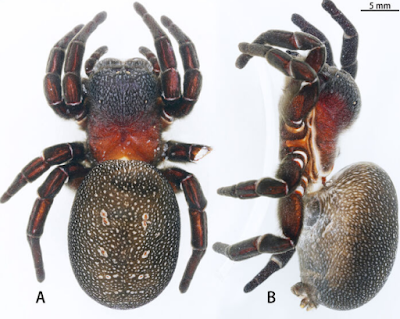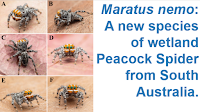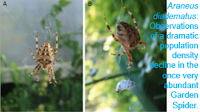Velvet Spiders, Eresidae, are a group of highly distinctive Spiders with an almost exclusively Old World distribution (a single species is known from Brazil). They are often brightly coloured (some species are known as Ladybird Spiders for this reason) and typically live within underground tubes lined with silk, acting as ambush predators in areas with low vegetation, and well drained soil. Unusually for Spiders, some species are social, living in large colonies which co-operate in the raising of young. Parental care is a one of the distinguishing features of Velvet Spiders, with the females actively feeding their young for some time after hatching, liquefying their own internal organs in order to do so. The bright colours and distinctive behaviour of Velvet Spiders, combined with a preference for land also favoured by Human farmers, has led to many species having protected status.
In a paper published in the Biodiversity Data Journal on 6 December 2022, Yejie Lin of the Hebei Key Laboratory of Animal Diversity at Langfang Normal University, Shuqiang Li of the Institute of Zoology of the Chinese Academy of Sciences, Xin Zhao and Zhanqi Chen of the Key Laboratory of Tropical Forest Ecology at the Xishuangbanna Tropical Botanical Garden, and Haifeng Chen, also of the Hebei Key Laboratory of Animal Diversity at Langfang Normal University, describe two new species of Velvet Spider from Xinjiang Province, China.
Both new species are placed in the genus Eresus, which gives its name to the group and which contains 24 of the 102 currently described Velvet Spider species.
The first new species described is named Eresus da, where 'da' is a Chinese word meaning 'large', in reference to the large size of the species, the carapace of which can reach over 10 mm in length. Only a single female specimen of this species were observed, this being dark brown in colour, except for the carapace which is a lighter, reddish brown, and the white spots on the abdomen, the whole body being covered by short, white hairs.
The single known specimen of Eresus da was found living in a silk tunnel about 20 cm in length sheltered behind a clump of desert plants, and connected to an underground nest. The entrance to the tunnel was surrounded by the empty exoskeletons of desert Beetles, which appear to be the main prey of this species.
The second new species is named Ersus yukuni, in honour of Yu Kun, who collected the single known specimen of the species, a male. The specimen is black in colour, and covered by a dense layer of black and white hairs.
See also...
Follow Sciency Thoughts on Facebook.
Follow Sciency Thoughts on Twitter.









